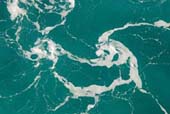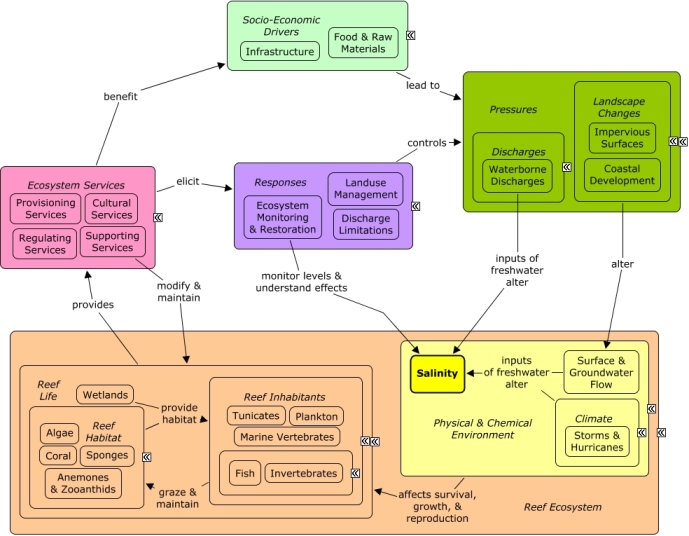ReefLink Database

Salinity
Salinity is the dissolved salt concentration in water, and is the key factor distinguishing ocean water from freshwater. Marine species typically tolerate a range of salinity from 33-37 parts per thousand.
CMap

CMap Description
Human activities that alter the landscape, including devegetation or soil disturbance, can alter surface and groundwater flow, causing freshwater discharge or runoff into coastal ecosystems, and altering salinity levels. Changes in salinity beyond the normal range of variability can affect the growth, reproduction, and survival of marine species. Salinity levels can be monitored and mapped to target sources of freshwater inputs or potentially vulnerable areas. Landuse management, agricultural practices, or mining practices can be implemented to minimize soil disturbance, impervious surfaces, and devegetation that alter surface and groundwater flow. Many of the same socio-economic sectors, such as transportation, civil engineering, and construction that create pressures on the reef also benefit from the goods and services, such as shoreline protection or recreational opportunities that contribute to the cultural identity of the local community.Citations
More than 50 citations. Click here to load.
| Citation | Year | Study Location | Study Type | Database Topics |
|---|
Management Options
| Management Option | Description | Sources | Database Topics |
|---|---|---|---|
| Agriculture & Aquaculture: Sodic Soil Management | In coastal agriculture it is important to manage and reduce accumulations of salts on the soil surface and down to the crop rooting depth. Saline seep often occurs in crop areas where the water table is very shallow. Irrigation management or drainage improvements may be necessary. Another option may be subsoiling, where internal soil drainage is restricted by layers of contrasting permeability and soil moisture levels are low enough to allow shattering and mixing of soil layers. Vegetative measures include planting deep rooted crops such as wheatgrass and alfalfa. Soil amendments can be used to treat sodium, displacing it with calcium depending on the specific chemistry of the soil. Though crop yield does not directly impact coral reefs, ground water restoration projects may change the raise the water table, making sodic soil management important. | Natural Resources Conservation Service. 2011. National Handbook of Conservation Practices. U.S. Department of Agriculture. |
Agriculture; Agriculture, Aquaculture, & Forestry Policies; Coastal Development; Ditching & Soil Disturbance; Food & Raw Materials; Landscape Conservation & Restoration; Salinity; Surface & Groundwater Flow; Water Depth & Sea Level |
| Monitor & Research: Water Quality Status and Trends Monitoring | This activity produces long-term, comprehensive information on sanctuary-wide status and trends of water quality parameters. Parameters that should be measured include temperature, salinity, dissolved oxygen, turbidity, relative fluorescence, light attenuation, nutrients, chlorophyll, and alkaline phosphatase activity. | NOAA Marine Sanctuary Program. 2007. Florida Keys National Marine Sanctuary revised management plan. National Ocean Service, Key West, FL. |
Applied Chemicals; Atmospheric Emissions; Calcium Carbonate Deposition; Carbon Storage & Cycling; Chemical Variables; Climate; Climate Regulation; CO2; Discharges; Ecosystem Monitoring & Restoration; Environmental Monitoring & Restoration; Environmental Monitoring, Mapping, & Scientific Research; Light; Nutrient & Contaminant Processing; Nutrients; Ocean Acidity; Physical & Chemical Water Quality Criteria; Physical Variables; Regulating Services; Salinity; Sea Temperatures; Sediment; Supporting Services; Toxics; Waterborne Discharges |
| Monitor & Research: Research Historical Hydrology | This activity involves a historical assessment of the hydrology of the surrounding water area around the sanctuary as it has affected water quality and biological communities within the sanctuary. It will clarify the role of freshwater inflows and water quality from local freshwater bodies. Also, this activity will examine the effects of structural modification and changes in quality, quantity, timing and distribution of freshwater releases from existing structures and will examine land-based practices affecting the water quality of runoff. | NOAA Marine Sanctuary Program. 2007. Florida Keys National Marine Sanctuary revised management plan. National Ocean Service, Key West, FL. |
Applied Chemicals; Chemical Variables; Coastal Development; Coastal Engineering; Dam Construction & Maintenance; Deforestation & Devegetation; Discharge Limitations; Discharges; Ditching & Soil Disturbance; Dredging, Draining, & Filling; Ecosystem Monitoring & Restoration; Environmental Monitoring & Restoration; Environmental Monitoring, Mapping, & Scientific Research; Hydrologic Management; Impervious Surfaces; Infrastructural Policies; Landscape Changes; Landuse Management; Physical Variables; Salinity; Seawater Flow; Shoreline Armoring; Stormwater Management; Surface & Groundwater Flow; Water; Water Depth & Sea Level; Water Transportation; Waterborne Discharges |
| Monitor & Research: Research Global Change | This management option involves research to examine the effects of stresses associated with global change on the ecosystem. Stresses can include changes in temperature, hydrology, salinity, frequency and intensity of storms, turbidity, sea level change, and ultra violet and visible radiation. | NOAA Marine Sanctuary Program. 2007. Florida Keys National Marine Sanctuary revised management plan. National Ocean Service, Key West, FL. |
Atmospheric Emissions; Calcium Carbonate Deposition; Carbon Storage & Cycling; Chemical Variables; Climate; Climate Regulation; CO2; Discharges; Ecosystem Monitoring & Restoration; Environmental Monitoring & Restoration; Environmental Monitoring, Mapping, & Scientific Research; Greenhouse Gas Emissions; Nutrient & Contaminant Processing; Ocean Acidity; Physical & Chemical Water Quality Criteria; Physical Variables; Regulating Services; Salinity; Sea Temperatures; Seawater Flow; Shoreline Protection; Storms & Hurricanes; Supporting Services; Surface & Groundwater Flow; Water Depth & Sea Level |
| Waterway Management: Collaborate with Projects Changing Water-Flow | Other organizations may be performing restorative freshwater projects (Everglades Restoration) or other flow altering projects (e.g. canals for small boats, agricultural irrigation etc) that affect the downstream marine management area (Florida Bay). Projects on the coast that involve hydrologic modifications (such as changing salinity) must be closely monitored in order to protect reef quality. Reefs are very sensitive systems and can only survive in a narrow salinity range. By taking an active role and monitoring freshwater flow projects, management staff can better ensure proper consideration of the impact on coastal marine environments. | NOAA Marine Sanctuary Program. 2007. Florida Keys National Marine Sanctuary revised management plan. National Ocean Service, Key West, FL. Comprehensive Everglades Restoration Plan. 2010. Comprehensive Everglades Restoration Plan: 2009 System Status Report. |
Collaboration & Partnering; Dam Construction & Maintenance; Decision Support; Discharge Limitations; Discharges; Ditching & Soil Disturbance; Ecosystem Monitoring & Restoration; Hydrologic Management; Landscape Changes; Point Source Discharges; Public Administration; Salinity; Security & Public Administration Policies; Surface & Groundwater Flow; Water Transportation; Waterborne Discharges |
Laws
| Legal Citation | Purpose of Law | Management Organization | Database Topics |
|---|
